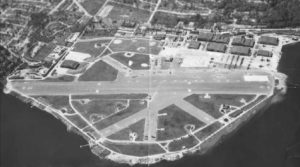About NAS Seattle
For much of the twentieth century, a Naval Air Base occupied the land at Sand Point, on the shores of Lake Washington. It is now home to Warren G. Magnuson Park, the National Oceanic and Atmospheric Administration (NOAA), and U.S.G.S. Western Fisheries Research Center.
As Seattle’s first municipal airport, Sand Point was the launch site of the first Around the World Flight in 1924, three years before Charles Lindbergh landed his Spirit of St. Louis on the runway to promote early airmail use. A young Boeing Company assembled and flew planes here.
During WWII, as Headquarters for the 13 District, the Naval Station Puget Sound led the fight in the Pacific Theater. After Pearl Harbor was bombed, NAS Seattle was one of only three Naval Air Stations on the west coast.
Magnuson Park is named for longtime Senator Warren G. Magnuson, who helped the City of Seattle acquire this property after it was 347 acres of the base was surplused in the early 1970s. NOAA and USGS received land at this time. The base reuse planning began in 1991 for the closure of Sand Point which was no longer needed by the Navy due to the transfer of functions to the new Naval Station Everett. By 1998 the remaining land and buildings were formally transferred to the City with 10 acres and 5 buildings to the University of Washington.
The sacrifices, time and energy of the people who served on the base have ennobled the land and buildings we now enjoy. These are the stories of some of the men and women who lived and worked at Sand Point
.
